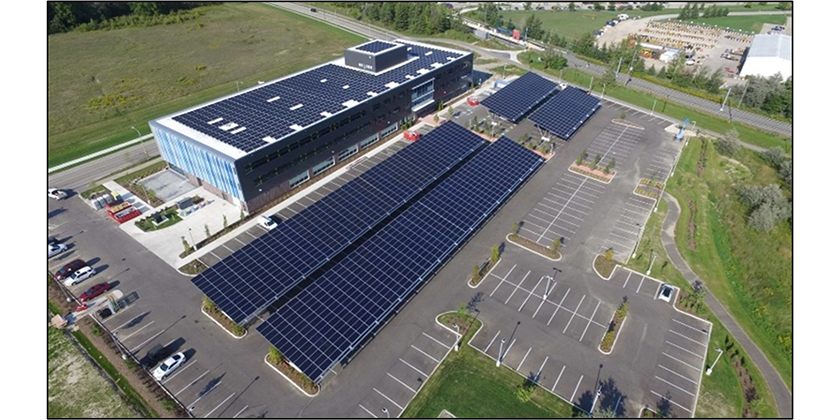Canada’s First Certified Zero-Carbon Building Offsets its Energy Use Over Three Years with Rooftop and Carport Solar System

October 21, 2024
The evolv1 building in the University of Waterloo Research and Technology Park in Waterloo, Ontario, has become self-sufficient in electricity following the installation of an innovative DC-optimized rooftop and carport solar system. Over a three year period, the system offset 105% of the facility’s energy use and saved approximately $360,000 in energy costs.
The evolv1 building become Canada’s first zero-carbon building to receive a design certification by the Canadian Green Building Council upon its completion. The evolv1 vision is a collaboration between building owner The Cora Group, Stantec, Sustainable Waterloo Region, the David Johnston Research & Technology Park, and anchor tenant EY.
“The Cora Group is a forward-thinking organization that leads by example when it comes to sustainability,” says Brian Unrau, President at renewable energy developer, VCT Group, the company chosen to design and install the solar system. “Reducing its energy bill was also a priority, especially given its recent decision to deploy 28 EV chargers within the facility’s grounds. There are lots of synergies between solar canopies and EV charging – the combination of the two technologies not only promotes sustainability but also positions the space for future growth and expansion, enhancing evolv1 as a modern, eco-friendly hub,” he adds.
VCT Group designed and installed a combined system, including a rooftop and parking lot canopies, totalling 768kW. The canopies are multifunctional, featuring modules that capture solar energy while providing shade for vehicles, adding aesthetic appeal to the space. Beyond energy generation, these canopies also save on snow-clearing efforts and offer secure storage space underneath. Together, these features enhance the overall user experience, especially for E-mobility and bike facilities, demonstrating an innovative blend of style and practicality.
The installation features 33kW SolarEdge DC-optimized inverters and SolarEdge Power Optimizers which are connected to each pair of modules. The optimizers maximize energy generation by overcoming issues such as module mismatch, soiling and shading that can significantly limit production in traditional, non-optimized systems. They also bring the advantage of greater design flexibility – an important consideration in installations such as this one where every watt of power matters.

“The SolarEdge system was crucial to realizing Cora Group’s vision of net-zero operation, which allows us to be free of fossil fuels,” states Unrau. “The evolv1 building has a mechanical penthouse on the roof that has a shading effect that moves through the array during the day, so being able to optimize the performance of each pair of modules was a big advantage. At the same time, the added design flexibility meant we were able to place modules on parts of the roof we would not otherwise have been able to, increasing the size of the system and, therefore, the amount of energy it can produce.”
SolarEdge’s suite of inbuilt safety features meant that VCT Group was also able to meet Ontario’s strict safety standards regarding rapid shutdown without adding unnecessary complexity to the project.
Unrau explains: “Without SolarEdge, we would have had to either position the inverters within a meter of the array—which could cause shading and interrupt the clean lines of the installation—or incorporate a third-party rapid shutdown device, creating additional potential points of failure. The SolarEdge solution gave us the best of both worlds, providing inbuilt rapid shutdown capabilities via its Power Optimizers, which meant we were able to place the inverters out of sight within the building. This enabled us to design a remarkably clean installation without any visible inverters ”

















